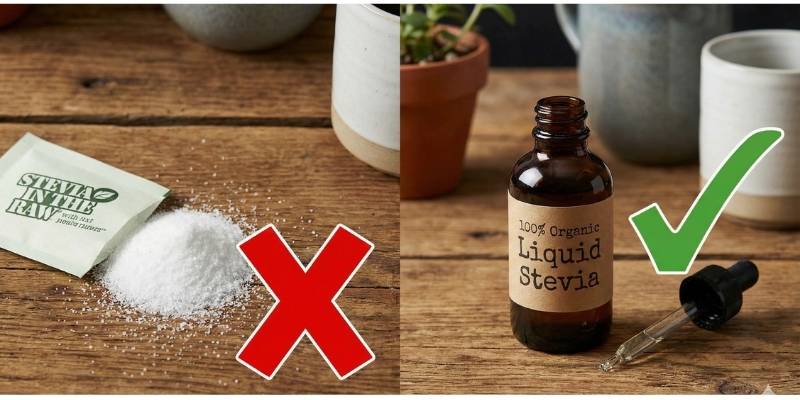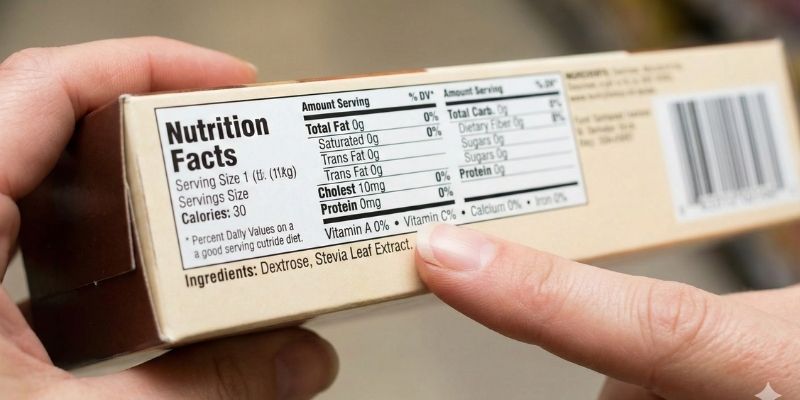The Stevia Purity Protocol: A Forensic Guide to Finding Pure Organic Stevia Brands 🕵️♂️🌱
You are standing in the supplement aisle, holding a green box that promises "100% Natural Sweetness," yet you feel a knot of hesitation in your stomach. You have cut the sugar, you are reading the blogs, and you are trying to protect your family from inflammation and insulin spikes—so why is finding pure organic stevia so incredibly confusing?
As a PhD student in agricultural sciences who also grew up with dirt under my fingernails on a family farm, I understand your frustration intimately. I’ve spent years analyzing crop production and processing, and I can tell you that what happens between the stevia leaf in the field and the packet in your hand is often more "chemistry lab" than "nature." You aren't just looking for a sweetener; you are looking for metabolic safety.
The truth is that most "stevia" products on the shelf are actually 99% filler. My goal today is to act as your trusted friend and scientific guide, helping you bypass the marketing hype to identify the pure organic stevia brands that actually deserve a place in your pantry. We are going to dismantle the "Dextrose Trap," analyze the emerging risks of Erythritol, and equip you with a forensic Purity Protocol so you never have to guess again.
📝 Summary in Bullets:
Your Immediate Protection Plan
If you are currently standing in the grocery store and need a quick "Yes" or "No" on a product, here is the bottom line on finding true purity:
- The "99% Filler" Rule: Pure organic stevia extract is 300 times sweeter than sugar. To make a powder measurable for your spoon, manufacturers must add bulking agents. If you buy a big bag of powder, you are mostly buying filler.
- The Insulin Trap: Avoid "Stevia in the Raw" or generic packets where the first ingredient is Dextrose (sugar) or Maltodextrin (corn starch). These spike your insulin just like table sugar.
- The Erythritol Warning: Many "Keto" brands use Erythritol. While better than sugar, it can cause severe bloating (the "Sponge Effect") and recent studies suggest potential heart health risks.
- The Liquid Mandate: Pure stevia extract in liquid form is almost always cleaner. It uses water or organic alcohol as a carrier, eliminating the need for powdered junk.
- The Gold Standard: Look for pure stevia extract liquids (list of brands below) or 100% pure micro-powders with zero other ingredients.
🧠 The Physics of Potency:
Why "Powder" Equals "Filler"

To understand the deception in the sweetener aisle, we have to look at the physics of the plant itself. Stevia rebaudiana is an incredibly potent herb. The sweet compounds inside the leaf, called Steviol Glycosides, are roughly 200 to 350 times sweeter than sucrose.
From an agricultural perspective, this is a miracle. But for a consumer, it presents a logistical nightmare: The Dosage Problem.
A single serving of pure organic stevia needed to sweeten your morning coffee is about 15 to 30 milligrams. That is an amount smaller than a match head. It is essentially invisible on a teaspoon.
The modern food industry knows that you expect to rip open a packet and pour out a white powder that looks like sugar. To bridge the gap between the microscopic dose of stevia and the visible volume you expect, manufacturers use "carriers" or "bulking agents." In a standard packet, the stevia represents less than 1% of the product. The other 99% is the carrier.
Therefore, when you buy a stevia packet, you are not buying stevia. You are buying the carrier. And that carrier is often a metabolic saboteur.
🧪 The "Dextrose
Trap": How "Zero Calorie" Spikes Insulin

This is the most common trap for diabetics and parents. You might pick up a box labeled "Stevia in the Raw" or a store-brand generic, assuming it’s safe.
If you turn that box over, the first ingredient is likely Dextrose or Maltodextrin.
- Dextrose is chemically identical to glucose (blood sugar). It has a Glycemic Index (GI) of 100.
- Maltodextrin is a processed starch that can spike blood sugar even faster than sugar (GI 105).
How is this legal? The FDA allows products with less than 5 calories per serving to be labeled "Zero Calorie." Because the serving size is so small, manufacturers can sell you pure sugar mixed with stevia and legally call it a zero-calorie diet product. It is a regulatory loophole that exploits your trust.
⚠️ The "Erythritol
Risk": Why "Natural" Isn't Always Safe
For years, health-conscious shoppers—perhaps you included—switched to blends using Erythritol (like Truvia) because it doesn’t spike insulin. It seemed like the perfect solution. However, my research as a PhD scholar compels me to share emerging data that suggests we need to be much more cautious.
The "Sponge Effect" (Gut Distress)
Erythritol is a sugar alcohol. While it tastes sweet, your body struggles to digest it. When it reaches your colon, it acts like a sponge, pulling water from your tissue into your intestine. This causes "osmotic diarrhea," bloating, and that familiar rumbling stomach many keto dieters experience.
The Cardiovascular Signal
More concerning is the data published in 2023 and 2024, including studies involving the Cleveland Clinic. Researchers found a correlation between high levels of circulating erythritol and "platelet reactivity." In simple terms, it makes your blood cells stickier and more prone to clotting.
While science is always evolving, for the "Proactive Protector" looking to minimize risk of heart attack or stroke, this is a massive red flag. This is why searching for pure stevia without Erythritol is becoming a critical health move.
💧 The Liquid Mandate: The
Path to True Purity

So, how do you avoid the fillers if you can't measure the powder? The answer lies in changing the state of matter: Switch to Liquid.
Liquid stevia drops solve the "Physics of Potency" problem without dangerous fillers. In a liquid product, the "carrier" is usually:
1. Water: Metabolically inert.
2. Organic Alcohol: Acts as a preservative; evaporates in hot coffee.
3. Vegetable Glycerin: A low-glycemic liquid thickener.
None of these spike insulin like dextrose, and none of them carry the clotting risks of erythritol. Pure liquid stevia is the closest you can get to the plant's natural benefits in a convenient form.
🔬 The Stevia Purity
Protocol: Preforganic.com Audit
✅ Tier 1: The Gold Standard (Buy
This)
- Form: Liquid Drops or Micro-Scoop Powder.
- Ingredients: Organic Stevia Leaf Extract, Water, Organic Alcohol (or Glycerin). Nothing else.
- Certification: USDA Organic (ensures no synthetic solvents like hexane were used in extraction).
Brands:
- Trader Joe's Organic Liquid Stevia: A cult favorite for a reason. Ingredients are just Water, Organic Alcohol, and Organic Stevia. It has a sharp, clean taste.
- SweetLeaf Sweet Drops (Glass Bottles): Water, Organic Stevia, Natural Flavors. (Note: Avoid their packets, which contain Silica and Inulin).
- Pyure Organic Stevia Extract Powder: If you must have powder, this brand sells 100% pure stevia extract powder with no fillers. You have to use a tiny micro-scoop (provided), but it is pure.
⚠️ Tier 2: The Caution Zone (Read
Carefully)
- Ingredients: Stevia + Erythritol or Inulin.
- Why: Safe for blood sugar, but high risk for bloating and potential long-term heart concerns.
- Brands: Truvia, Pyure (Granular), Splenda Naturals.
🚫 Tier 3: The Red Light
(Put It Back)
- Ingredients: Stevia + Dextrose, Maltodextrin, or "Natural Flavors" (if they are the primary ingredient).
- Why: Metabolic disturbance. Spikes insulin.
- Brands: Stevia in the Raw, Great Value (Walmart), Granulated, most "Baking Blends."
🧬 Advanced Purity: Reb A
vs. Reb M
If you want to get really nerdy with me (and I hope you do!), look for the specific type of glycoside.
- Reb A (Rebaudioside A): The industry standard. Sweet, but can have that "licorice" or metallic bitter aftertaste.
- Reb M (Rebaudioside M): The "Cadillac" of stevia. It is found in tiny amounts in the leaf but tastes almost exactly like sugar with zero bitterness. New pure organic stevia brands are starting to highlight "High Reb M" content. If you see this, grab it—it’s the future of clean taste.
Conclusion: Reclaiming Your Metabolic Sovereignty
Navigating the food industry is not easy, but you are no longer walking blindly. You now possess the knowledge to distinguish between a "natural" marketing scam and a metabolically safe tool.
By adhering to the Stevia Purity Protocol and embracing the Liquid Mandate, you are stripping away the industrial noise. You are rejecting the Dextrose Trap and sidestepping the Erythritol Risk. Whether you choose a bottle of Trader Joe's drops or a bag of pure stevia extract from Micro Ingredients, you are making a choice that honors your health and the health of your family.
From my farm to your table, remember: Real food doesn't need to hide behind a label. Trust the ingredients, not the front of the box. 🌱💪
- Home
- Stevia Dangers
- Stevia Leaf Extract
- Pure Organic Stevia
📚 Further Reading from
Authority Sources
2. Center for Science in the Public Interest (CSPI)
